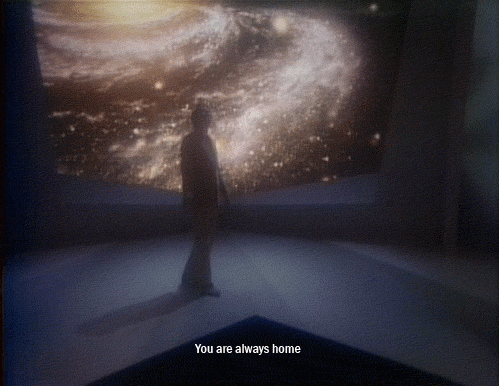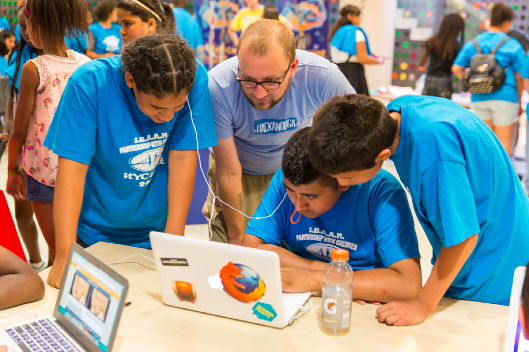My friends at Data and Society ran an excellent conference today in NYC. A speaker dropped out at the last minute and I got asked less than 48 hours ago to give a talk… a very specific talk. Here’s what I came up with, more or less.
I’m pinch hitting here, as we had a speaker who couldn’t join us, so I apologize for an unpolished talk without slides. To make my life easier, our friends at Data and Society asked me to tell a story I’ve told before. As I thought about it, I realized I wanted to tell that story very differently. So here’s a story that starts with one of the most embarrassing moments of my professional career and ends up on one of the most experimental and difficult projects I’ve ever worked on. Basically, it’s a story about the gap between ambitions, intentions and the compromises we make to bring ideas to life.
Twenty years ago, in 1996, I was 23 years old, and somehow was the chief tech guy for Tripod.com, which thought it was a lifestyle site for recent college graduates, but was actually one of the world’s first user-generated content sites. By 1999, we were hosting free webpages for 15 million users, which made us the 8th biggest website in the world. But in 1996, we were trying to figure out how to pay for the massive bandwidth bills we’d suddenly incurred by letting thousands of people publish whatever they wanted on our server.
Advertising was the business model everyone else was using on the internet, and so we joined in – we put banner ads on top of the pages users hosted with our service. Great! Until we got a call from one of our ad sales guys, who giving a demo to the Ford motor company, and found a Ford banner on top of a page enthusiastically and visually celebrating the joys of anal sex. (Lesson one – don’t let ad guys give live demos. Lesson two – don’t ever program a “show me a random page” button, no matter how easy it would be to implement.)
Ford was understandably upset, and so my boss demanded I do something. And while I should have figured out how to minimize the amount of pornography we were hosting on the site, my immediate reaction was to figure out how we could somehow distance ads from user generated content. I designed a navigation window that featured Tripod branding, links to our edited content, and an ad, and used a just invented javascript function, window.open(), to open a new window on top of the browser window the user’s page lived in.
Yes, I invented the pop-up ad. And yes, I’m very, very sorry.
In reflecting on my sins, I’ve publicly decried advertising as the original sin of the web. Not all advertising – I have a soft spot for advertising targeted by user intent, like ads matched to search engine queries. But the ads we use to support the services we use everyday, our social networks and webmail, are almost necessarily going to fail – they’re trying to distract us from seeing our our friends’ baby pictures or hear about the weekend’s debauchery. And so these ads have become deeply surveillant, encouraging us to use whatever data we can glean about the context they’re shown in, and anything we can learn about a user’s demographics, psychographics and behavioral data in the desperate hope that we might click on them. And I fear that the rise of surveillant ads may be slowly training us all to expect to be surveilled at all time, a development that’s dangerous for us as citizens, not just as consumers.
But it’s way too easy to beat up on advertising. It’s a really tough problem to figure out how to support services that require network effects to be effective. Facebook wouldn’t be the useful behemoth it is today if it were a hundredth or a tenth the size. It’s useful because there’s the reasonable assumption that anyone you know will be on the service, even if they use it fairly rarely. it’s the universality that makes it so useful, and universal services require near-zero cost of entry.
Yes, we eventually could have supported Tripod with paid subscriptions… and Facebook could and should offer a non-surveillant, paid service for power users. Gmail should agree not to surveil the email of anyone paying for disk space. YouTube shouldn’t track the users who pay for ad-free RedTube. But there’s got to be a way for me to be findable by my high school friends, even if I don’t want to use the tool everyday. For the activist in Egypt to put up a webpage calling people out into the streets in a way where she doesn’t need to pay with a credit card and reveal her identity. Advertising is problematic solution, and it’s led us some troubling places. But I’m starting to worry about a bigger problem.
The mistake we made with Tripod was deeper than the pop-up ad. In retrospect, I feel like our whole business model – the business model I spent two years persuading my boss to adopt – is starting to destroy the web, this strange and beautiful creature I’ve been in love with for the past 22 years.
What Tripod did was take something that was possible for technically sophisticated users – to put up a webpage – and make it possible for orders of magnitude more users. and that was a good and important thing to do, much as letting people share photos and videos with each other, or send 140 character messages to each other is a Good Thing. But the way we did it sucked. We took the great genius of the web – the idea that everything could live on its own box, but be connected to everything else by the wonder of the hyperlink – and replaced it with a single server, controlled by a single company. This made it vastly easier for someone to put up a webpage without learning how to install apache and to write HTML, but it also meant that we had control over what you wrote. If you wanted to share your enthusiastic love for anal sex, too bad, because Tripod banned almost all nudes, and enforced the ban aggressively, with a combination of automation and human filtering. And so if you find yourself with certain types of speech – wanting to share information on breastfeeding on Facebook, for instance – you’re going to face the complicated reality that our digital public spaces are owned and controlled by corporations that we have little control or influence over.
A few years ago, cyberutopians of my generation, people who weren’t dumb enough to believe that the internet would automatically make the world a better place, but were dumb enough to believe that the values and tendencies of the internet would lead us towards a better world, started to find ourselves in crisis. One of the great hopes we’d had was that the internet inherently fights centralization. That barriers to entry are so low that there will always be competitors, always be options. When Amazon is eating all retail, Facebook all communication, Google all discovery, it’s hard to believe this anymore. And so it’s time to stop being so enthusiastic and uncritical about the internet and to start thinking hard about the downsides of this approach we’ve adopted.
My friend Rebecca MacKinnon encourages us to think of ourselves as citizens, not just as consumers, and to demand basic rights on these platforms. Others have proposed that we start thinking about how we regulate these platforms as if they were utilities, recognizing that they provide essential services and that we need to ensure everyone can access them. I want to suggest something even more radical.
I think the future of the web – the future I want for the web – comes from radical decentralization. The really radical version of Tripod – impossible at that point in time, but maybe possible now – would have been building tools that helped people publish their own content on their own servers they control under their own rules.
Here’s what I’m working on now – in all the classes I teach, students turn in their work on blogs. But I control those blogs, and at the end of the semester, I end up controlling their work. What I want is a system in which students have their own blogs, share the appropriate posts with me for the semester so I can aggregate them into a class site, but they end up owning their words and coming away from their time with a portfolio of work on their sites. This is not a new idea – The University of Mary Washington has a project called A Domain of One’s Own where there are accounts on a shared wordpress install. But I’m trying to solve this problem in a ludicrously convoluted way
I’m trying to build a system where my students use a tool that’s as beautiful and easy as Medium, but stores the data on multiple places all over the web using IPFS, the IP file system. Rather than keeping an index of the students in my classes and where those blogs are located, the system uses the bitcoin blockchain to register contracts about where I can find their writings for class. I’m building this in an insanely complicated way because the same architecture lets me build a distributed but compatible version of Twitter – if I decide I don’t want Twitter having control over my tweets anymore, I can start publishing my own twitter-like feed on a website I control, then register contracts that say that’s where my tweets live. If you use a compatible client, and you decide to follow me on Twitter, your client will check the blockchain to see if I’ve registered a contract to publish my updates off twitter and then subscribe to that RSS feed. If not, it will look for me on Twitter and subscribe to that feed. Basically, I’m trying to build a system with as few centralized points of control as possible, in the hopes of making it both easy for anyone to publish and disseminate information, and difficult for anyone intentionally or inadvertently to act as a censor or gatekeeper.
But it’s really hard. We didn’t design Tripod centrally because we were censorious control freaks. It’s way, way easier to build a single, central database than to distribute a directory of users across a distributed hash table. The sort of system I’m describing is probably 1000 times less efficient than existing centralized systems. That inefficiency has consequences, of cost, and for the environment. And there are enormous problems with managing content in a system like this one – it may not be possible to demand deletion of content in a truly distributed system, so what do we do with truly offensive content, like revenge porn.
And yet, it’s probably what we need to do. Because giving control over public spheres to private companies isn’t just a bad idea for us as citizens – it’s an impossible set of responsibilities for the corporations in question, and they’re already starting to strain under the load. And so we need to start thinking about how we build systems that aren’t just new and innovative, but that are architected in ways that support the generativity and creativity of the web in the long term. This isn’t a brave new world – it’s a rescue mission. It’s a return to the past, to the way the web used to work. And while building a decentralized web didn’t work the first time around, because the easy solutions won out against the right ones, we can do it right now, because we understand the dangers of centralization. We’ve seen how the story plays out.
To be clear, I’m not the only one trying to build these new systems. From the bitcoin libertarians to the openhearted cyberhippies like Brewster Kahle, people are building new ways to publish, discover and pay each other for content in ways that don’t require a gatekeeper standing in the middle of these transactions. But we need a much bigger group of people taking on this challenge, deciding to build a web that works in a way that empowers rather than imprisons us. As you’ve figured out, I’m not very smart – I’m the dumbass that thought that pop-up ads were a good solution to internet pornography. I need you, whether you’re motivated by curiosity, by ideology or by opportunity, to join me and take on this task. It’s hard to do, but it’s also right.


 Nokia, the Finnish company that was once popular for making Symbian based smartphones, today announced that it will be making a return to the smartphone and tablet market. The company itself will not be manufacturing phones, but it has granted HMD, a new company “led by some of the world’s top mobile specialists,” the license to manufacture and sell Nokia-branded smartphones, tablets, and even feature phones for the next 10 years.
Nokia, the Finnish company that was once popular for making Symbian based smartphones, today announced that it will be making a return to the smartphone and tablet market. The company itself will not be manufacturing phones, but it has granted HMD, a new company “led by some of the world’s top mobile specialists,” the license to manufacture and sell Nokia-branded smartphones, tablets, and even feature phones for the next 10 years.












 Meghan is a meal-planning, food-prepping, Pinterest addict. She likes coffee – a lot. A mom of 2 boys, Meghan has a Bachelor of Arts with a major in Psychology, which she uses on a daily basis when helping customers create memories. Meghan is honoured to witness your histories unfold in real-time.
Meghan is a meal-planning, food-prepping, Pinterest addict. She likes coffee – a lot. A mom of 2 boys, Meghan has a Bachelor of Arts with a major in Psychology, which she uses on a daily basis when helping customers create memories. Meghan is honoured to witness your histories unfold in real-time.

 Samsung has updated its Always On Display app through the Galaxy Apps store for the Galaxy S7 and S7 edge to add new functionality to them. Among other changes, the update introduces the ability to only enable Always On Display during a certain time of the day.
Samsung has updated its Always On Display app through the Galaxy Apps store for the Galaxy S7 and S7 edge to add new functionality to them. Among other changes, the update introduces the ability to only enable Always On Display during a certain time of the day.








